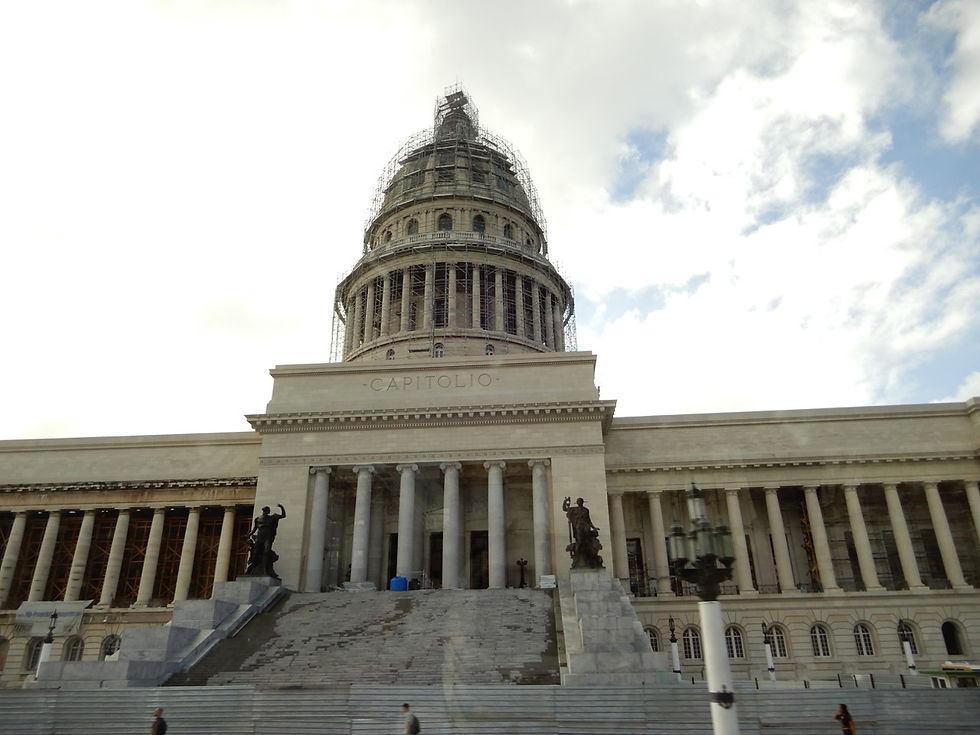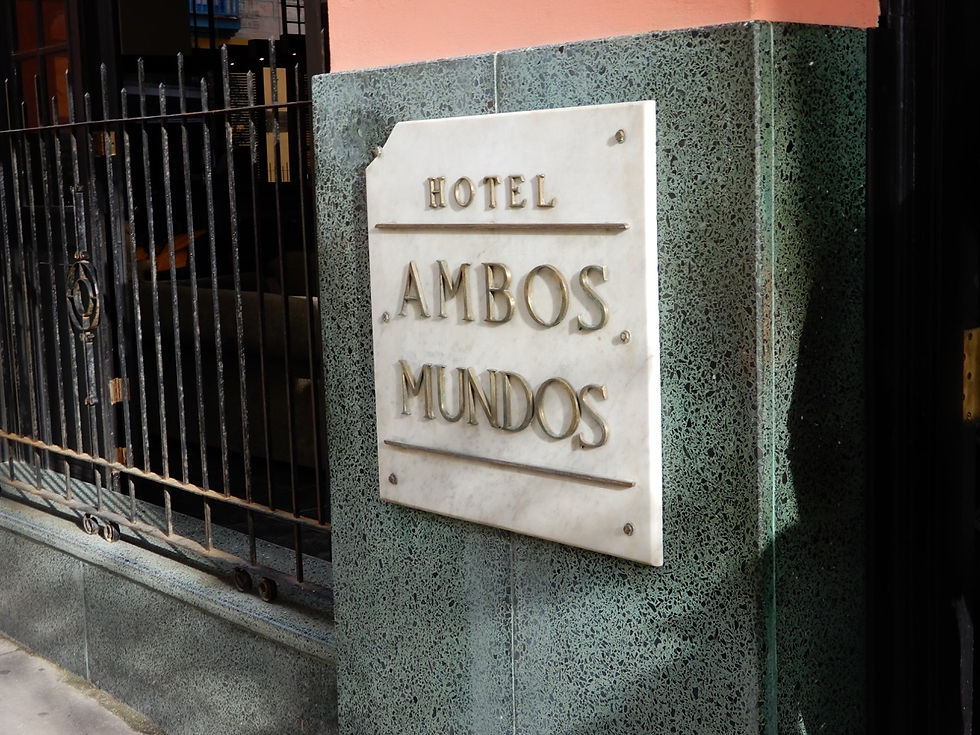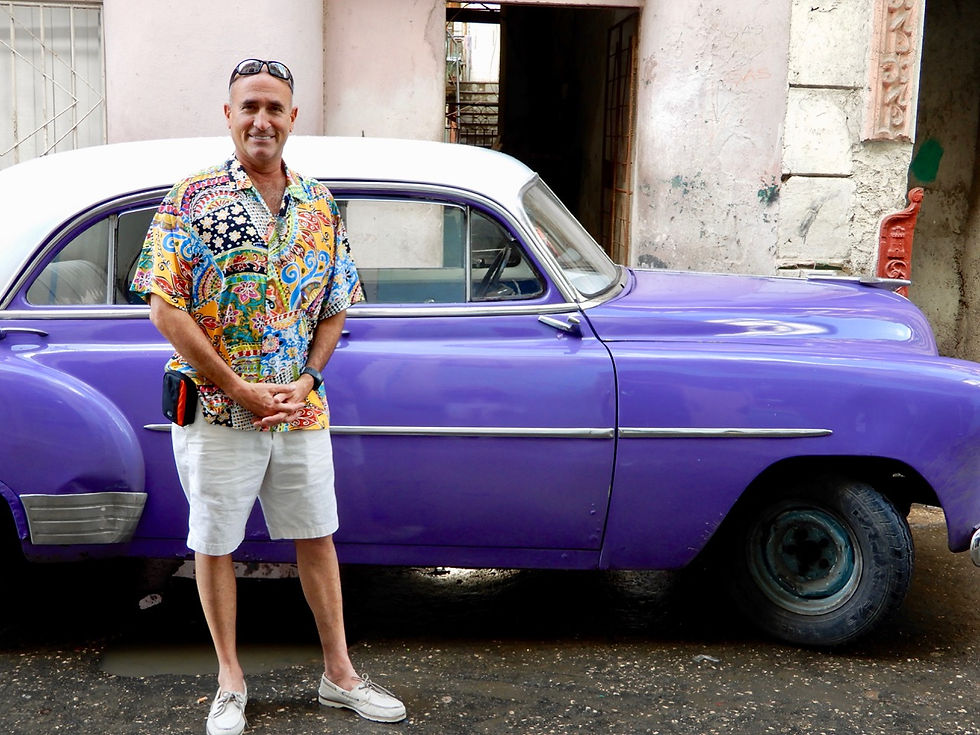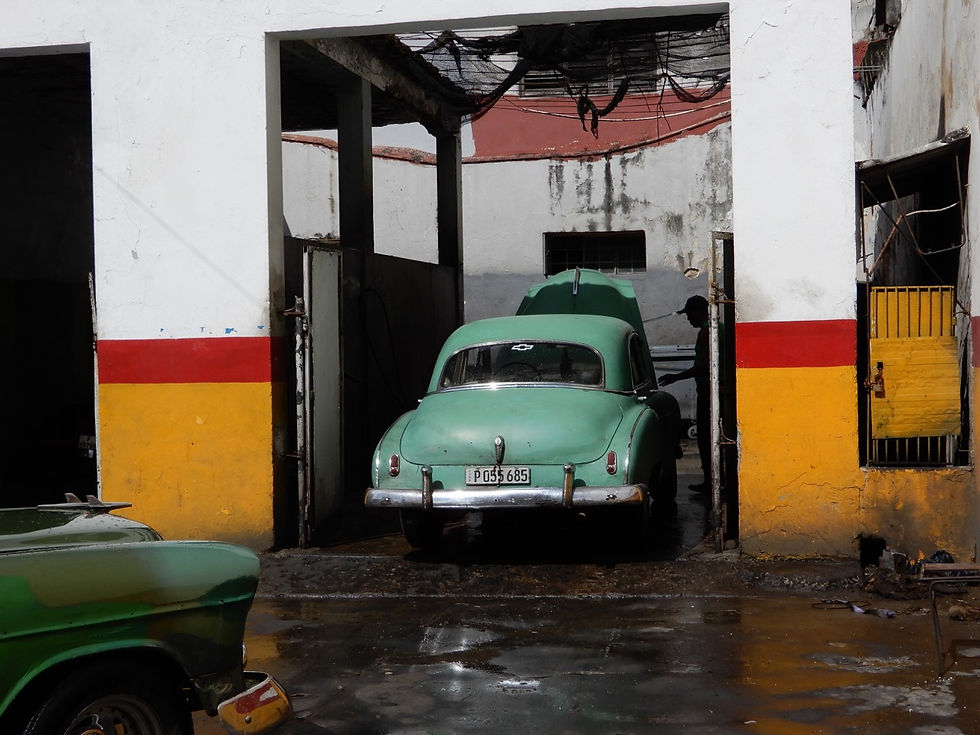Havana, Cuba (2)
- Peter Antonucci

- a few seconds ago
- 8 min read
Tuesday | November 14, 2017
After an early and long (3 hour) bus ride, we arrived in Havana, Cuba. Wow, is this a special place or what?!
Havana, the capital of Cuba and one of the 14 provinces of the Republic of Cuba, moved to its current site in 1519 and rapidly evolved to become Spain’s key to the New World. Remaining a prosperous city into the mid-20th century, Havana has now become a vacation destination since Cuba reopened to tourism in the 1990s.
Much of the city’s charm can be found among the narrow streets packed with crumbling buildings and fascinating people. Every open door and overhanging balcony allows glimpses of rocking chairs and colorful washing hanging on lines, all accompanied by strains of music. On the streets, Chinese-made bicycles, yellow, egg-shaped coco-taxis and two-humped camello (camel) buses weave among the melee of 1950s cars.
Havana can be divided into four main areas: the Old Quarter, which as the name suggests, is the historic heart of the city and was declared a UNESCO World Heritage Site in 1982; Central Havana contains the famous Paseo del Prado, Capitolio building and many outstanding museums; Vedado is considered the modern political and cultural center and includes Revolution Square; and Miramar to the west is Havana’s most elegant quarter, with Quinta Avenida’s splendid villas that are now home to foreign embassies.
Perhaps the entire experience was made even more special by President Trump's pronouncement last week that US citizens were no longer allowed to visit Cuba under the terms of his “America first” policy.

David was our guide. After receiving his law degree in Cuba, he traveled to Seattle where he obtained his masters in law from the University of Washington. He also has a dry and fun sense of humor.
Of the approximately 11.2 million citizen of this island nation, 120,000 live in Havana. The entire nation state of Cuba is only 88,000 square miles, or approximately the size of Tennessee. Contrary to what is portrayed in the media, 85% of Cubans own their own homes.
Along the drive, we encountered many old, dusty, filthy buses.

These buses are run by the state, and they are always late and uncomfortable. As a result, we saw hundreds, if not thousands, of Cubanos standing along the roads in the cities and the highways with their thumbs out looking for rides.
David also explained that organic gardens are grown virtually every city. Interestingly, we didn’t see a single lawn mower instead, we saw men cutting grass with sickles.

The highways here are nothing like the highways in America. Just imagine the potholes, and surprises that will occur along a road if it is not maintained or resurfaced for 60 years. (If one were to connect a Fitbit to the bus seatback, one might even register an extra 10,000 steps!)
We also drove by the national soccer stadiums, baseball field, and water polo facility. They almost looked unsafe to sit in, although we are told they are still being used on a regular basis
The former Central Palace of the country sits in the middle of the square.

This was built in 1917, apparently by Louis Tiffany. This was the headquarters for Batista when he ran the country. (When Castro took over, he lived in the Hilton Hotel for the rest of his life. Apparently he enjoyed having cocktails sent up from room service every day.)
In the center of town, we came upon a military museum. Outside it, and prominently placed, are the scraps and engines from the US U2 plane that was shot down over Cuba.



It was not until 1997 that the United States government acknowledged the plane as one of ours and allowed the pilot’s mother entry into Cuba to bring home his remains.
This delivery truck, like the Trojan Horse, hid young student revolutionaries intent on killing Batista.

It turned out to be a bad day for them, as his guards gunned them down before they could complete their intended task.
Finally, we arrived at the Museo Nacional de Bellas Artes.
This interesting building, which is loosely modeled after the Guggenheim Museum in New York City, is located on the space that used to be an open air Spanish market. As result, and as a tribute to that heritage, there is an open air component of the museum on the first floor.

On that same first floor, there was a sculpture made entirely of coffeepots.

There was also this sculpture, which I’m told is art.

This massive cockroach is a bit more like it – and made me think of New York.

Our museum guide explained that Cuba is comprised of indigenous people, Afro-Cubans, and some Chinese who were brought in as slaves. Among the famous national artists whose works we viewed are Eduardo Abela, Victor Manuel Garcia, and Antonio Gattorno. In the works of these artists, and with many of the others in the museum, it is evident to see the influence of the Spanish and French cultures of the 1920s, 30s, and 40s. Many of these artists visited those countries during those decades and their work is similar to the masters who came before them. Many of them are dark with dark brown backgrounds. Some of the subjects are angry while others are historical and tell stories about the Cuban countryside. One artist, Santiago Armada, trafficked in graphic, virtually pornographic art, which became popular in the 1960s. Also evident were pictures that were influenced by Peter Max or Andy Warhol, from that period.
As we left the museum, David spoke briefly about the censor process. He said that Cuban citizens are known to buy a “weekly pack” which consists of movies, major league baseball games, and series from HBO, Netflix, or any other US medium. They’re delivered to the houses every Friday, on thumb drives, by someone who is in that business. As a result, it is to be presumed Cubans see the exact same television shows and sporting events we do, only a week later.
The capital of Cuba is based on the capital of United States, but Cuba took the liberty of making its capital 2 meters higher than that of the US.

There is a tiny section of the city that comprises their Chinatown.

David explained there are no native Chinese people in Havana, but the area is noteworthy because it was here, in 1998, that people opened the first paladar in Cuba (as discussed in yesterday’s posting). And on that note, it was time for us to visit our first paladar, Paladar San Cristobal. Located in the heart of central Havana, this paladar has a reputation of excellence in both atmosphere and local cuisine. We enjoyed a terrific lunch with a local atmosphere that took us back into the 1940s and 50s.

We were served an array of appetizers.

And the lobster main course was wonderful (although I had pork).

After lunch, I needed to make a phone call, although some of my younger friends did not recognize this device as being a telephone.
Not wanting to be sent to the central military detention facility depicted here, I decided to be a good boy for the rest of the afternoon.

It was during the afternoon, on our way to visit a few other places, that we got to walk the streets of Havana, perhaps one of the highlights of the day. Although I could easily find words to describe the street scenes, and the conditions of the old buildings, I think it best to allow these photographs to tell the story without interruption from me.





If the buildings do not look secure to you, that is because they are not. We are told that 3.4 houses collapse daily within the city of Havana alone.
The streets themselves were abysmal.

We peeked into a few homes and up their staircases.


Look at those electric meter boxes. Electricity here is a joke, with wires hanging everywhere and open sources of fire plentifully available.


The faces of the people here were priceless.


We were ushered into a small jazz club where three top Cuban jazz musicians performed live for us.

The gentleman in the front is musical historian Alberto Faya, who took us through 500 years of the influences and progression of Cuban music in less than 30 minutes. The keyboardist, a 25-year-old who bore a striking resemblance to a young A-rod, may be the best keyboardist I have seen in my life, in any discipline, in any performance arena, around the world - and I've seen some of the best.
When we asked about bars and places to go later in the evening, we were told that Tropicana is a very happening place, but it really doesn’t open until 2:00 AM. Consequently, it is a fair bet that we will be sound asleep by then!
Our next stop was the Mundos Hotel.

Built in 1924 on a site that had previously been occupied by an old family house, this hotel was home to Ernest Hemingway for seven years in the 1930s while he was between the ages of 28 and 35. This is the actual room in which he stayed.

After this period, he traveled back and forth between Havana and the United States before finally shooting himself to death in Idaho in 1961. It was in this very room he wrote three of his earlier novels, Hills of Africa, Death in the Afternoon, and To Have and Have Not.

Interestingly, we learned from the guide at this facility that Hemingway had a practice of typing while standing up, although this photograph belies that fact.

This is the actual typewriter he used.

And this was his view.

The closet held his clothes; he was not a small man.

In this room, he sometimes hosted his good friends such as F. Scott Fitzgerald who would come down to visit him for weeks at a time.
After leaving the hotel, we walked the streets a little more and came upon more and more of the classic cars for which Havana is famous. Apparently there are 350,000 of these cars on the island of Cuba and approximately 80% of them live in Havana.







Automotive purists would scoff at many of the cars because of the renovations and alterations that have been done to them. For example, almost every one of their engines had been replaced by a Hyundai, Toyota or Russian engine. And most of the engines are diesel. A lot of the cars, such as this 1955 Chevrolet Bel Air we rode in, have been modified to include air conditioning, AM/FM stereo, electric windows and doors, and other conveniences that were clearly not available in 1955.

This wall depicted here, is a remnant of the wall that encircled the city in 1837 when this island town was the sugar capital of the world

Our final organized stop of the afternoon was the visit to the Lizt Alfonso Academy where we were treated to a private performance by this phenomenal adolescent dance group.

This women-led dance company at the school for local youth has received global recognition for his performance in the music video “Bailando” which was filmed at the dance academy, and its performance at the 2016 Latin Grammy awards. In November 2016, this academy was presented with an International Spotlight award by Michelle Obama.


At the dance studio, the program is home to 1300 students, 1250 of whom are women. They begin at age 6 and from ages 6 to 16, they practice 2 two hours a day after school. From ages 9 to 12, they’re culled into smaller groups and after age 14, 20 kids make the cut to the next level. There are 400 professional dancers, of whom five are men. Approximately 300 dancers travel each year 220 different countries, 200 cities, and participate in the 40 international tours, giving 500 performances worldwide.
After the performance, David walked us through some food markets and showed us the ration tickets given to each citizen.
With those tickets, they are able to present them at stores like these, and pick up their allowance of rice, grains, beans, and sausages.


At the end of our walk, we ended up at the Floridita, a bar frequented by Ernest Hemingway. His statue adorns the bar, with an always ready frozen margarita.

I got my own.

After only 20 minutes to shave, shower, and dress, we all met downstairs for dinner. We took a short cab ride to where we enjoyed dinner . There, at another palador, we walked four flights up to the restaurant.
This was the former home of a prominent doctor in Havana. (He must have been prominent – the house was enormous!)


After dinner, we walked up another few flights of stairs to the top of the building where we had a beautiful panorama of Havana.
















Comments